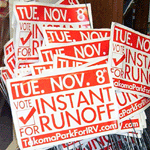84% in Takoma Park: Lessons from a landslide win
 On
November 8, 2005, voters in the Washington, D.C. suburb of Takoma
Park, Maryland voted 84%-16% to adopt instant runoff voting (IRV) for
city elections, winning 1,992 to 390. A majority of the council has
pledged to implement IRV for the next city elections for mayor and city
council in 2007.
On
November 8, 2005, voters in the Washington, D.C. suburb of Takoma
Park, Maryland voted 84%-16% to adopt instant runoff voting (IRV) for
city elections, winning 1,992 to 390. A majority of the council has
pledged to implement IRV for the next city elections for mayor and city
council in 2007.What made this campaign so successful? We wanted to share a few thoughts for would-be reformers. In brief, they are: try to take the issue of costs off the table; gain support of local leaders; make sure it speaks to the elections one is seeking to change; and don't oversell the reform.
- Negating issue of costs: IRV in Takoma Park will not save the city
money, as it will replace one-round plurality voting rather than a
two-round system. But at the same time, implementation will be very
inexpensive. That was due to first persuading the city to move away
from the county-owned touchscreen voting machines and implement a paper
ballot system. That change saved the city money and avoided paperless
voting, but it also made it easy to do a hand-count of ballots for IRV.
Costs therefore were barely discussed in the campaign.
- Strong support among city leaders: Because FairVote's executive
director Rob Richie and two of FairVote's board members have lived in
Takoma Park for years, they knew many city leaders. Richie worked with
the council and city clerk in moving to paper ballots, and was able to
talk about IRV with most of the city council and other civic leaders,
including the two county commissioners living in the city. Ultimately
the measure was placed on the ballot by a unanimous vote, and nearly
everyone of consequence in city politics and civic life (PTA
presidents, religious leaders, etc) was publicly supportive or at least
neutral.
- Pitching the right message to speak to the electorate: Like many
cities, Takoma Park is open to new ideas. Many of its voters are
well-versed in debates over "spoilers." They also have a one-round
system of voting that under the old plurality system had allowed
someone to win with less than a majority of the vote. It was valuable
to focus on what IRV would do for the city: accommodate the potential
of voter choice to generate a majority winner.
- An energetic campaign: The costs of the campaign were low -- less
than $1,400 -- but energy level was high.. The campaign had a
well-designed postcard that went to likely voters and a similar
literature piece dropped at nearly every home in the city by
volunteers. Volunteers engaged in lots of conversations at the city
gatherings and at the Metro stop and wrote good pieces in local
publications. At least two people covered the polling place all
Election Day.
